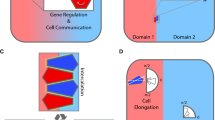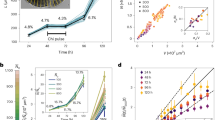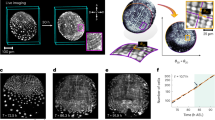Abstract
THE cellular slime mould Dictyostelium discoideum (Dd) has proved suitable material for investigation of pattern formation. The morphogenetic field controlling Dd aggregation is now uniquely well characterised1–6. Whether its characteristics are unique or universal is not known. Here, I help to put the slime mould into a general perspective by comparing its pattern formation with that of another well studied organism. I have used grafting experiments to investigate secondary axis regulation in the Dd slug. The experiments parallel the use of grafts by Wolpert and collaborators to elucidate hypostome regulation in hydra7,8. They show that hydra and the slug use formally similar mechanisms for axis regulation. The known features of the Dd aggregation control system suggest that this does not account for axis regulation in the slug. (Details of the experimental procedure are given in Fig. 1 legend.)
This is a preview of subscription content, access via your institution
Access options
Subscribe to this journal
Receive 51 print issues and online access
$199.00 per year
only $3.90 per issue
Buy this article
- Purchase on Springer Link
- Instant access to full article PDF
Prices may be subject to local taxes which are calculated during checkout
Similar content being viewed by others
References
Bonner, J. T., J. exp. Zool., 106, 1–26 (1947).
Konijn, T., et al., Proc. natn. Acad. Sci. U.S.A., 58, 1152–1154 (1967).
Shaffer, B. M., Adv. Morphogen., 2, 109–182 (1962); Nature 225, 549–552 (1975).
Gerisch, G., Current Top. dev. Biol., 3, 159–198 (1968).
Robertson, A., et al., Science, 175, 333–335 (1972).
Durston, A. J., Devl Biol., 37, 225–235 (1974).
Hicklin, J., Hornbruch, A., Wolpert, L., and Clarke, M., J. Embryol. exp. Morph., 30, 3, 701–725 (1973).
Wolpert, L., et al., Symp. Soc. exp. Biol., 25 (edit. by Davies, D., and Balls, M.), (Cambridge University Press, London, 1971).
Raper, K., J. Elisha Mitch. Sci. Soc., 56, 241–282 (1940).
Farnsworth, P., J. Embryol. exp. Morph., 29, 2, 253–266 (1972).
Webster, G., J. Embryol. exp. Morph., 16, 105–122 (1966).
Hicklin, J., et al., J. Embryol. exp. Morph., 33, 499–510 (1975).
Gierer, A., and Meinhardt, H., Kybernetik, 12, 30–39 (1972).
Lawrence, P., et al., J. Cell Sci., 11, 815–853 (1971).
Nanjundiah, V., J. theor. Biol., 56, 275–282 (1976).
Takeuchi, I., Dev Biol., 8, 1–26 (1963).
Gregg, J., Devl Biol., 12, 377–393 (1965).
Author information
Authors and Affiliations
Rights and permissions
About this article
Cite this article
DURSTON, A. Tip formation is regulated by an inhibitory gradient in the Dictyostelium discoideum slug. Nature 263, 126–129 (1976). https://doi.org/10.1038/263126a0
Received:
Accepted:
Issue Date:
DOI: https://doi.org/10.1038/263126a0
This article is cited by
-
An individual-level selection model for the apparent altruism exhibited by cellular slime moulds
Journal of Biosciences (2018)
-
Quantitative analysis of the spatial distribution of ultrastructural differentiation markers during development ofDictyostelium discoideum
Wilhelm Roux's Archives of Developmental Biology (1983)
Comments
By submitting a comment you agree to abide by our Terms and Community Guidelines. If you find something abusive or that does not comply with our terms or guidelines please flag it as inappropriate.



